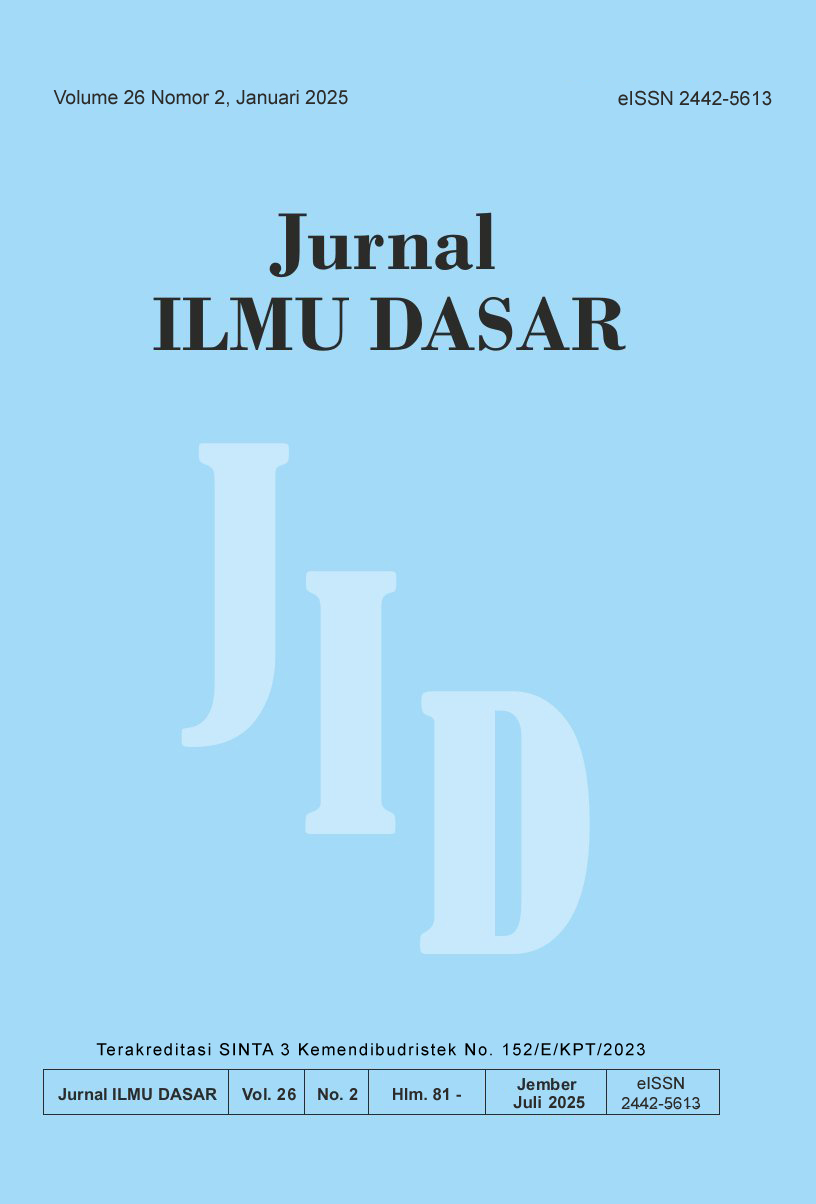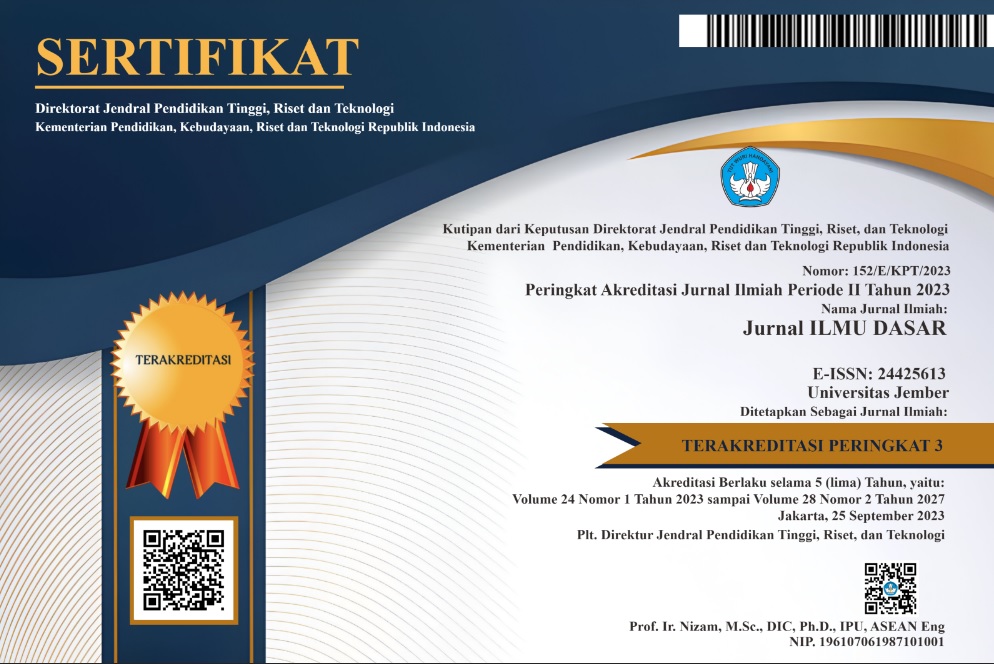Metabolite Profile of arabica Coffee Cascara from Typica Cultivar in Bandung with Different Drying Processes
DOI:
https://doi.org/10.19184/jid.v26i2.52756Keywords:
Caffeine, Direct sun, Gas Chromatography-Mass SpectrometryAbstract
Arabica coffee bean (Coffea arabica L.) is Indonesia's leading commodity, with Bandung Regency as the largest producer in West Java. The exocarp and mesocarp of coffee fruits known as cascara have potential health benefits as a beverage. Cascara is usually dried by direct sunlight before consumption, but this process is prone to weather disturbances and contamination. The use of dehydrators is more controlled to maintain metabolite content, but there has been no research on cascara from coffee cultivars in Bandung Regency dried by this method. This study aims to obtain the metabolite profile of Typica arabica coffee cultivar cascara dried using direct sun and dehydrator. The cascara samples were taken from Gunung Puntang Coffee Plantation, Bandung Regency, and extracted using maceration method with 70% ethanol p.a. solvent. The metabolite content was analyzed by Gas Chromatography-Mass Spectrometry (GC-MS), which specifically detects volatile metabolites. Non-volatile compounds were not within the scope of this study. The results showed that direct sun-dried cascara had 6 metabolites, while dehydrator-dried had 15 metabolites. Both samples were dominated by caffeine (sun-dried cascara: 46.61%, dehydrator cascara: 24.44%). Five metabolites were found in both samples, with 1 unique metabolite in solar cascara and 10 unique metabolites in dehydrator cascara. This study showed differences in metabolite content in Typica cultivar cascara with different drying methods.
Downloads
References
Aronson, J. & Ebeler, S. E. (2004). Effect of Polyphenol Compounds on the Headspace Volatility of Flavors. American Journal of Enology and Viticulture, 55(1), 13-21. https://doi.org/10.5344/ajev.2004.55.1.13
Arpi, N., Muzaifa, M., Sulaiman, M. I., Andini, R. & Kesuma, S. I. (2021). Chemical Characteristics of Cascara, Coffee Cherry Tea, Made of Various Coffee Pulp Treatments. IOP Conference Series: Earth and Environmental Science, 709(1), 012030. https://doi.org/10.1088/1755-1315/709/1/012030
Avato, P. & Tava, A. (2022). Rare Fatty Acids and Lipids in Plant Oilseeds: Occurrence and Bioactivity. Phytochemistry Reviews, 21(2), 401-428. https://doi.org/10.1007/s11101-021-09770-4
Badan Pusat Statistik (2023). Statistik Kopi Indonesia 2022. Jakarta: Badan Pusat Statistik.
Bobková, A., Poláková, K., Demianová, A., Belej, Ľ., Bobko, M., Jurčaga, L., Gálik, B., Novotná, I., Iriondo-DeHond, A. & Castillo, M.D. (2022). Comparative Analysis of Selected Chemical Parameters of
123 Coffea arabica, from Cascara to Silverskin. Foods, 11(8), 1082. https://doi.org/10.3390/foods11081082
Bondam, A. F., da Silveira, D. D., dos Santos, J. P. & Hoffmann, J. F. (2022). Phenolic Compounds from Coffee By-products: Extraction and Application in the Food and Pharmaceutical Industries. Trends in Food Science & Technology, 123, 172-186. https://doi.org/10.1016/j.tifs.2022.03.013
Csapó, J., Prokisch, J., Albert, C. & Sipos, P. (2019). Effect of UV Light on Food Quality and Safety. Acta Universitatis Sapientiae, Alimentaria, 12(1), 21-41. https://doi.org/10.2478/ausal-2019-0002
Dong, W., Hu, R., Chu, Z., Zhao, J. & Tan, L. (2017). Effect of Different Drying Techniques on Bioactive Components, Fatty Acid Composition, and Volatile Profile of Robusta Coffee Beans. Food Chemistry, 234, 121-130. https://doi.org/10.1016/j.foodchem.2017.04.156
Dudek, K., Pietryja, M. J., Kurkiewicz, S., Kurkiewicz, M., Błońska-Fajfrowska, B., Wilczyński, S. & Dzierżęga-Lęcznar, A. (2022). Influence of the Drying Method on the Volatile Component Profile of Hypericum perforatum Herb: A HS-SPME-GC/MS Study. Processes, 10(12), 2593. https://doi.org/10.3390/pr10122593
Fithriyyah, D., Wulandari, E. & Sendjaja, T. P. (2020). Potensi Komoditas Kopi dalam Perekonomian Daerah di Kecamatan Pangalengan Kabupaten Bandung. Mimbar Agribisnis: Jurnal Pemikiran Masyarakat Ilmiah Berwawasan Agribisnis, 6(2), 700-714. https://doi.org/10.25157/ma.v6i2.3408
Gemechu, F. G. (2020). Embracing Nutritional Qualities, Biological Activities, and Technological Properties of Coffee Byproducts in Functional Food Formulation. Trends in Food Science & Technology, 104, 235-261. https://doi.org/10.1016/j.tifs.2020.08.005
Heeger, A., Kosińska-Cagnazzo, A., Cantergiani, E. & Andlauer, W. (2017). Bioactives of Coffee Cherry Pulp and its Utilisation for Production of Cascara Beverage. Food Chemistry, 221, 969-975. https://doi.org/10.1016/j.foodchem.2016.11.067
Heo, J., Adhikari, K., Choi, K. S. & Lee, J. (2020). Analysis of Caffeine, Chlorogenic Acid, Trigonelline, and Volatile Compounds in Cold Brew Coffee Using High-Performance Liquid Chromatography and Solid-Phase Microextraction—Gas Chromatography-Mass Spectrometry. Foods, 9(12), 1746. https://doi.org/10.3390/foods9121746
Hu, D., Liu, X., Qin, Y., Yan, J., Li, R. & Yang, Q. (2023). The Impact of Different Drying Methods on the Physical Properties, Bioactive Components, Antioxidant Capacity, Volatile Components and Industrial Application of Coffee Peel. Food Chemistry: X, 19, 100807. https://doi.org/10.1016/j.fochx.2023.100807
Indrayani, N. M. K., Sunaryono, J. G. & Purwanti, E. W. (2022). Analisis Nilai Tambah Kulit Kopi Arabika (Coffea arabica) Sebagai Produk Olahan Teh Celup Cascara di Desa Taji Kecamatan Jabung Kabupaten Malang. Jurnal Pengolahan Pangan, 7(2), 67-74. https://doi.org/10.31970/pangan.v7i2.77
International Coffee Organization (2023). Coffee Report and Outlook December 2023. London: International Coffee Organization.
Iriondo-DeHond, A., Iriondo-DeHond, M. & del Castillo, M. D. (2020). Applications of Compounds from Coffee Processing By-Products. Biomolecules, 10(9), 1219. https://doi.org/10.3390/biom10091219
Jain, D. & Tiwari, G. N. (2003). Thermal Aspects of Open Sun Drying of Various Crops. Energy, 28(1), 37-54. https://doi.org/10.1016/S0360-5442(02)00084-1
Jiménez-Zamora, A., Pastoriza, S. & Rufián-Henares, J. A. (2015). Revalorization of Coffee By-products: Prebiotic, Antimicrobial and Antioxidant Properties. LWT - Food Science and Technology, 61(1), 12-18. https://doi.org/10.1016/j.lwt.2014.11.031
Kachroo, A. & Kachroo, P. (2009). Fatty Acid–Derived Signals in Plant Defense. Annual Review of Phytopathology, 47(1), 153-176. https://doi.org/10.1146/annurev-phyto-080508-081820
Kaido, B. & Takashino, N. (2023). Comparative Challenges, Cost, and Profitability of Cooperative versus Noncooperative Farmers: Case of Arabica Coffee in Indonesia. Food Research, 7(2), 297-306. https://doi.org/10.26656/fr.2017.7(2).510
Kaur, N., Chugh, V. & Gupta, A. K. (2014). Essential Fatty Acids as Functional Components of Foods - A Review. Journal of Food Science and Technology, 51(10), 2289-2303. https://doi.org/10.1007/s13197-012-0677-0
Komaria, N., Suratno, Prihatin, J. & Sudarti (2020). An Analysis of Innovation on the Utilization of Cascara by Coffee Farmers. Journal of Physics: Conference Series, 1563(1), 012015. https://doi.org/10.1088/1742-6596/1563/1/012015
Lestari, W., Hasballah, K., Listiawan, M. Y. & Sofia, S. (2023). Antioxidant and Phytometabolite Profiles of Ethanolic Extract from the Cascara Pulp of Coffea arabica Collected from Gayo Highland: A Study for Potential Anti-photoaging Agent. F1000Research, 12(1), 1-15. https://doi.org/10.12688/f1000research.120278.2
Lo, Y. & Hwang, S. (2024). Enhancing Natural Enemy Performance through Plant Secondary Metabolites: The Role of Caffeine for the Parasitoid Snellenius manilae. Journal of Applied Entomology, 148(3), 330–338. https://doi.org/10.1111/jen.13228
124
Lovestead, T. M. & Urness, K. N. (2019). Gas Chromatography/Mass Spectrometry. New York: ASM Handbook.
Mariamenatu, A. H. & Abdu, E. M. (2021). Overconsumption of Omega-6 Polyunsaturated Fatty Acids (PUFAs) versus Deficiency of Omega-3 PUFAs in Modern-Day Diets: The Disturbing Factor for Their “Balanced Antagonistic Metabolic Functions” in the Human Body. Journal of Lipids, 2021, 1–15. https://doi.org/10.1155/2021/8848161
Mróz, M., Parchem, K., Jóźwik, J., Domingues, M. R. & Kusznierewicz, B. (2024). The Impact of Different Drying Methods on the Metabolomic and Lipidomic Profiles of Arthrospira platensis. Molecules, 29(8), 1747. https://doi.org/10.3390/molecules29081747
Murlida, E., Noviasari, S., Nilda, C., Rohaya, S., Rahmi, F. & Muzaifa, M. (2021). Chemical Characteristics of Cascara Tea from Several Varieties of Coffee in Aceh Province. IOP Conference Series: Earth and Environmental Science, 667(1), 012078. https://doi.org/10.1088/1755-1315/667/1/012078
Pua, A., Choo, W. X. D., Goh, R. M. V., Liu, S. Q., Cornuz, M. E. K., Sun, J., Lassabliere, B. & Yu, B. (2021). A Systematic Study of Key Odourants, Non-volatile Compounds, and Antioxidant Capacity of Cascara (Dried Coffea arabica Pulp). LWT, 138, 110630. https://doi.org/10.1016/j.lwt.2020.110630
Rohloff, J. (2015). Analysis of Phenolic and Cyclic Compounds in Plants Using Derivatization Techniques in Combination with GC-MS-Based Metabolite Profiling. Molecules, 20(2), 3431–3462. https://doi.org/10.3390/molecules20023431
Tallima, H. & El Ridi, R. (2018). Arachidonic Acid: Physiological Roles and Potential Health Benefits – A Review. Journal of Advanced Research, 11, 33–41. https://doi.org/10.1016/j.jare.2017.11.004
Tenyang, N., Ponka, R., Tiencheu, B., Djikeng, F. T. & Womeni, H. M. (2020). Effect of Traditional Drying Methods on Proximate Composition, Fatty Acid Profile, and Oil Oxidation of Fish Species Consumed in the Far‐North of Cameroon. Global Challenges, 4(8), 2000007. https://doi.org/10.1002/gch2.202000007
Utami, N. F., Elya, B., Hayun & Kusmardi. (2022). Measurement of Quality Non-specific and Specific Parameters of 70% Ethanol Extract and Simplicia from Cascara Coffee Robusta (Coffea canephora L.) and Its Potency as Antioxidant. IOP Conference Series: Earth and Environmental Science, 1116(1), 012008. https://doi.org/10.1088/1755-1315/1116/1/012008
Wood, S., Sage, J. R., Shuman, T. & Anagnostaras, S. G. (2014). Psychostimulants and Cognition: A Continuum of Behavioral and Cognitive Activation. Pharmacological Reviews, 66(1), 193–221. https://doi.org/10.1124/pr.112.007054
Xiao, S., Li, H., Xu, M., Huang, K., Luo, Z. & Xiao, L. (2021). A High-throughput Method for Profiling Fatty Acids in Plant Seeds Based on One-step Acid-catalyzed Methylation Followed by Gas Chromatography-Mass Spectrometry. Biotechnology & Biotechnological Equipment, 35(1), 1076–1085. https://doi.org/10.1080/13102818.2021.1954552
Zioud, A., Hajji, W., Lobón, S., Joy, M., Bertolin, J. R., Smeti, S., Chabbouh, M., Bellagha, S. & Essid, I. (2023). Effects of Drying Methods on Chemical Composition, Lipid Oxidation, and Fatty Acid Profile of a Traditional Dried Meat Kaddid. Foods, 12(20), 3837. https://doi.org/10.3390/foods12203837
Downloads
Published
Issue
Section
License
Copyright (c) 2025 Zaki Fahreza Sururi, Sariwulan Diana, Kusdianti Kusdianti

This work is licensed under a Creative Commons Attribution-ShareAlike 4.0 International License.








